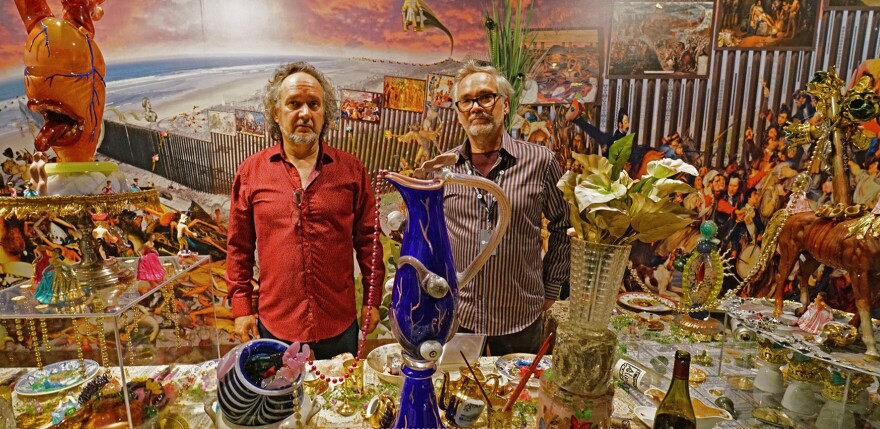A riotous celebration of culture, color, and creativity — that’s how Mint Museum uptown officials describe "Collidoscope: de la Torre Brothers Retro-Perspective," on display through Sept. 21. The exhibition showcases 30 years of collaborative work by internationally acclaimed brothers Einar and Jamex de la Torre.
They were born in Guadalajara, Mexico, but moved to California when they were young. Today, they have studios in both places, where they create brilliantly colorful, multi-layered glassworks and lenticulars of all shapes and sizes that represent their culture and society’s ills and norms. In this interview with WFAE’s Gwendolyn Glenn, they describe their work — first, Einar de la Torre.
Einar de la Torre: Early in our work, we used a lot of pre-Colombian imagery, mostly because it's so fantastically rich. And since we grew up Catholic, there's a lot of Baroque taste — very much that comes from all those boring hours looking at all the scenery inside the church. We're very influenced by the German Expressionists as well because we like full, human expression. We want to express the human condition because right now — we all feel a lot of anxiety because everything in the world is so crazy. We want to completely express that. We want to put the mirror to our culture and to our society and have people see it reflected.
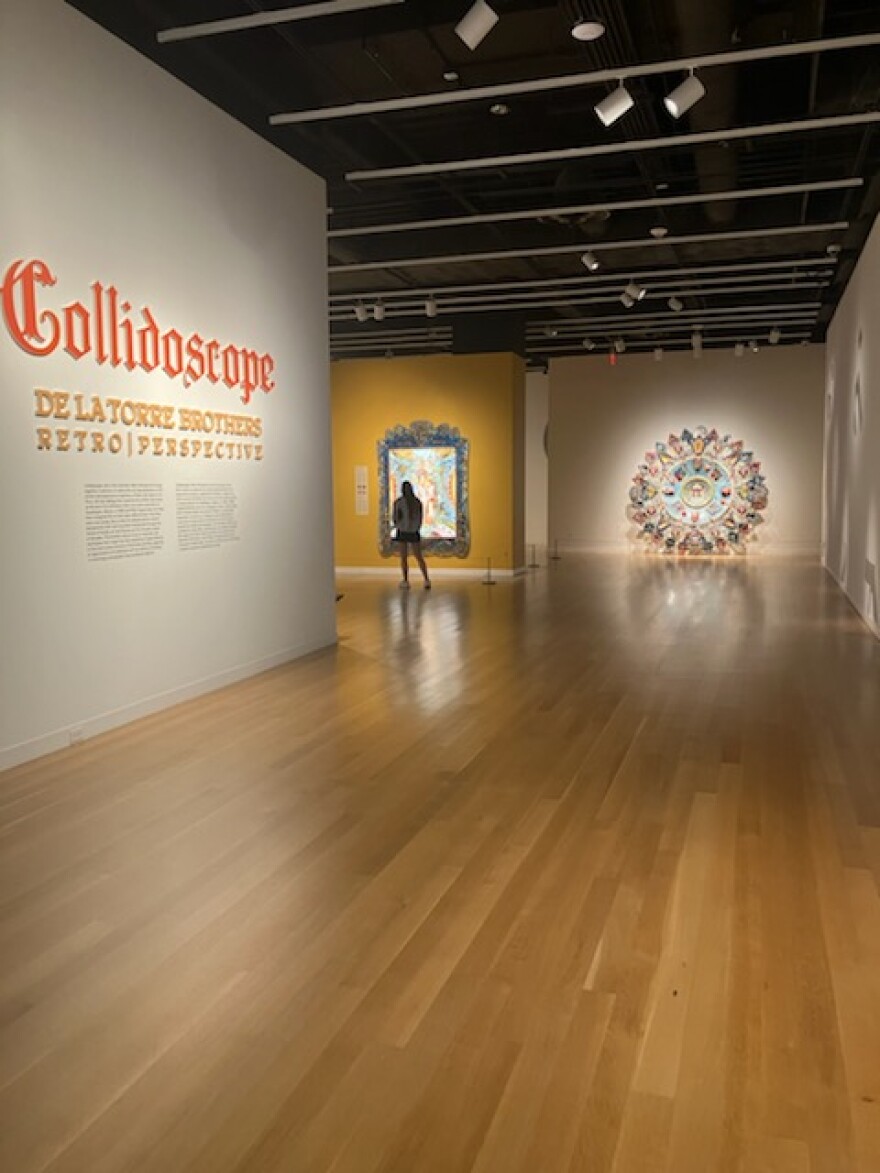
Gwendolyn Glenn: So, let's go back a bit. How did you guys find this love for the glass blowing that you guys do?
Jamex de la Torre: We were both in art school, aiming to get a traditional training in sculpture. That's what we wanted. And the glass was like just a class on the side. And it's one of those mediums that, when you're receptive, it just reels you in.
Glenn: Einar?
Einar de la Torre: It's quite addictive because it's a good way to get ideas out. We all joke that we have ADD — so that we have ideas and we want to make them and move on to the next one. And glass has that immediacy. Some of the bigger pieces might be two or three hours with a team of people. That's still relatively small compared to chasing bronze pieces or carving out stone or even wood.
Glenn: Now, when you guys got the bug to do this, did you think at the time that you would always be collaborating?
Jamex: No, at that time when we got the bug, we were doing personal work. I was more sculptural, figurative. And he was more exploring color techniques applied to glass. So, eventually, when we were in our 30s, we decided to collaborate in full.
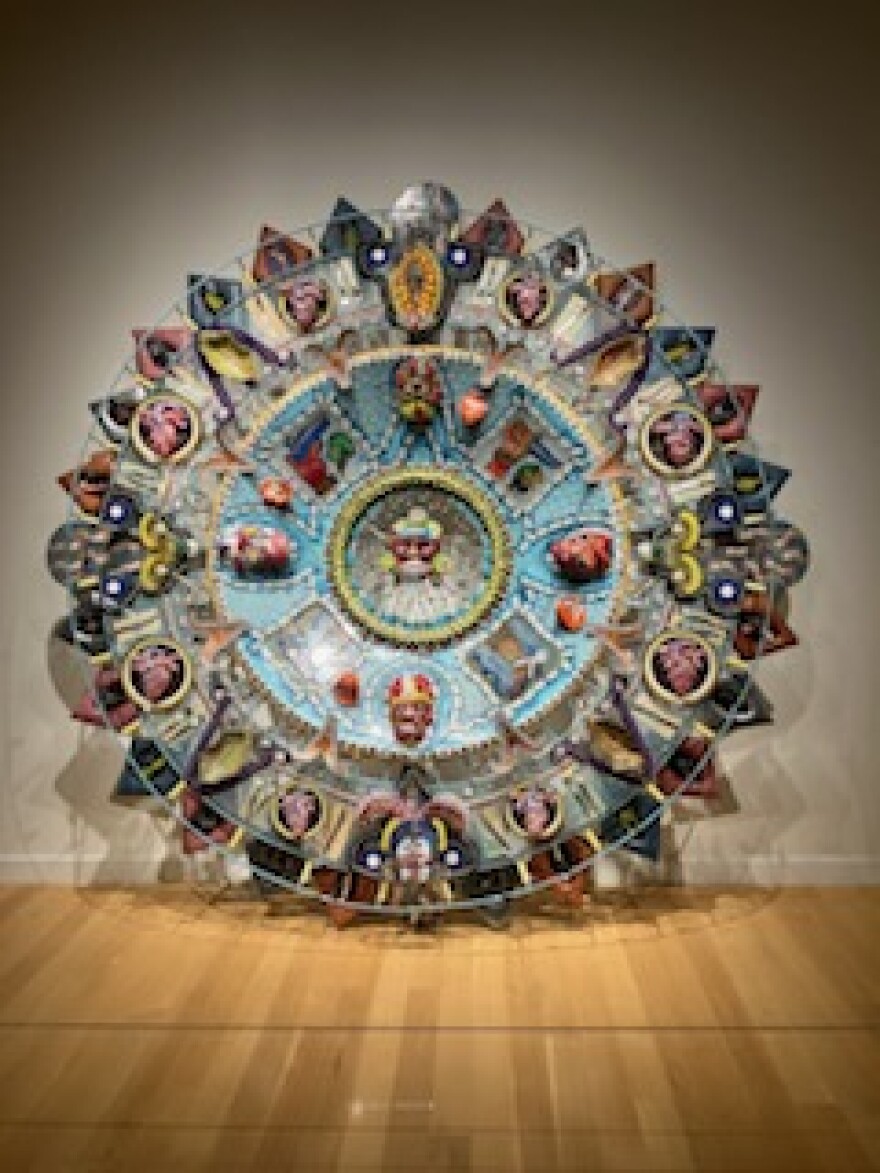
Glenn: Do you disagree at times on what a piece should or shouldn't be?
Einar: Yeah, we do. But it usually comes down to who persists the most. Collaboration is tricky because there has to be complete trust. It has to be completely fair, too. And as a collaborator, not having the complete responsibility for the piece is kind of liberating.
Jamex: And also, I think I would add to that, that the process of collaboration isn't so much that one of us gives and then we do the idea that the other has. It is more of a buy-in. I come with five ideas or seven — and he does [too]. And we figure out what we both get excited about, and then we just collaborate and layer that stuff on top of each other as opposed to, 'we’ll make what you said' or 'we’ll make what I said.'
Glenn: Now, I saw a video of you two working with students and others. But one of you said that the search for identity is a big part of your work. Could you explain that? What did you mean by that?
Einar: All artists try to find what is, in essence, coming in their soul, right? And I think we did the same. When we were young artists in our school, we were perplexed as to what we could do with all this minimalist stuff that was so popular in the 1980s. We could not fit our brains into taking that direction. And to us, it was the complete opposite. So, our work being so Baroque and so full of stuff is not everybody's cup of tea either, but it definitely is — or what we grew up with. What seems natural to us.
Jamex: To that point too, to be more specific about identity, I think it's pretty natural for the immigration experience that we have, being born in Guadalajara, Mexico, [going to an] all-boys Catholic school in Southern California. And there was co-ed school and hot pants and miniskirts and all these things that blew our little minds. And I think that culture shock still is very much part of our work.
When you have two cultures that are so strong and distinct, and they're right next to each other, identity issues are obviously a big deal. So, when we're Mexican and we became American in the United States, it really makes you think about your identity because you have the outsider status on either culture.
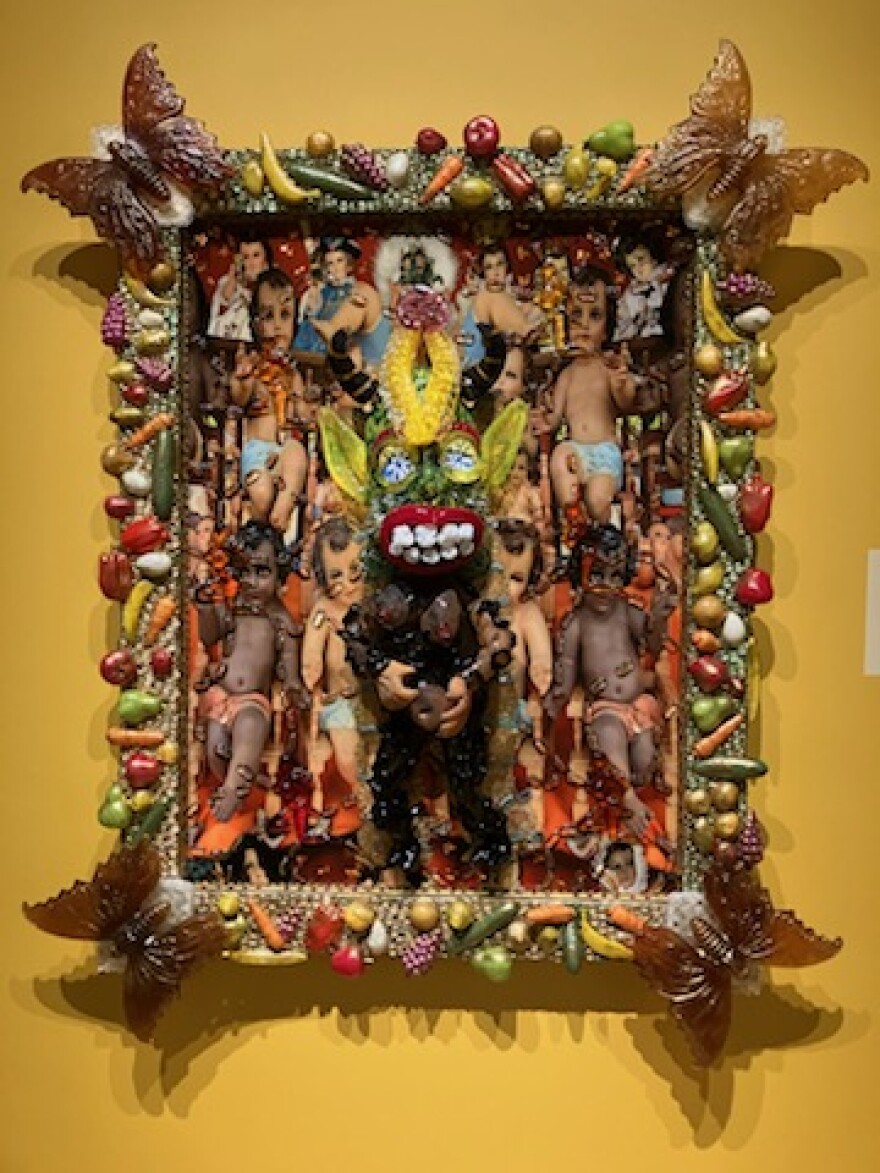
Glenn: 'Collidoscope,' is here in Charlotte. Explain the name and what that means?
Jamex: 'Collidoscope' is the mixture of collision and the regular kaleidoscope, which is the, you know, instrument where you look through a mirrored passageway into refracting images that make up a kind of a star. And we wanted to say that it was a collision in the sense in that the kaleidoscope had a collision — in this case, cultural imageries and icons and concepts and even political.
Glenn: Give me an example of how this is expressed in some of the works. Say, for instance, the one with the butterflies.
Jamex: That is totally a bunch of collision. That one has a lot to do with being children of the '60s, drugs and the sexual revolution, all these things. We grew up with that kind of mentality. Even though we weren't living as adults at the time, we were children (but) it really influenced us.
So, in this case, this is a very sort of groovy, crazy piece about kind of tripping. But at the same time, the objects are acquired from both sides of the border. And I think in some cases they're Dollar Store stuff, because we go to Dollar stores and we question how we feel about acquiring something that represents a culture that is made on the other side of the world?
Glenn: 'Darwin's secret,' the one with the babies, surrounding what looked like a dragon figure. What was behind that?
Einar: Well, Darwin — genius that he was — he also managed to stay a religious man. So, we got the baby Jesus go all the way around him, right? It’s his little secret.
Jamex: And it's also sort of a monkey on his back — that he wanted to reconcile the changes that he saw because of science and creation and the whole idea that everything was made in seven days.
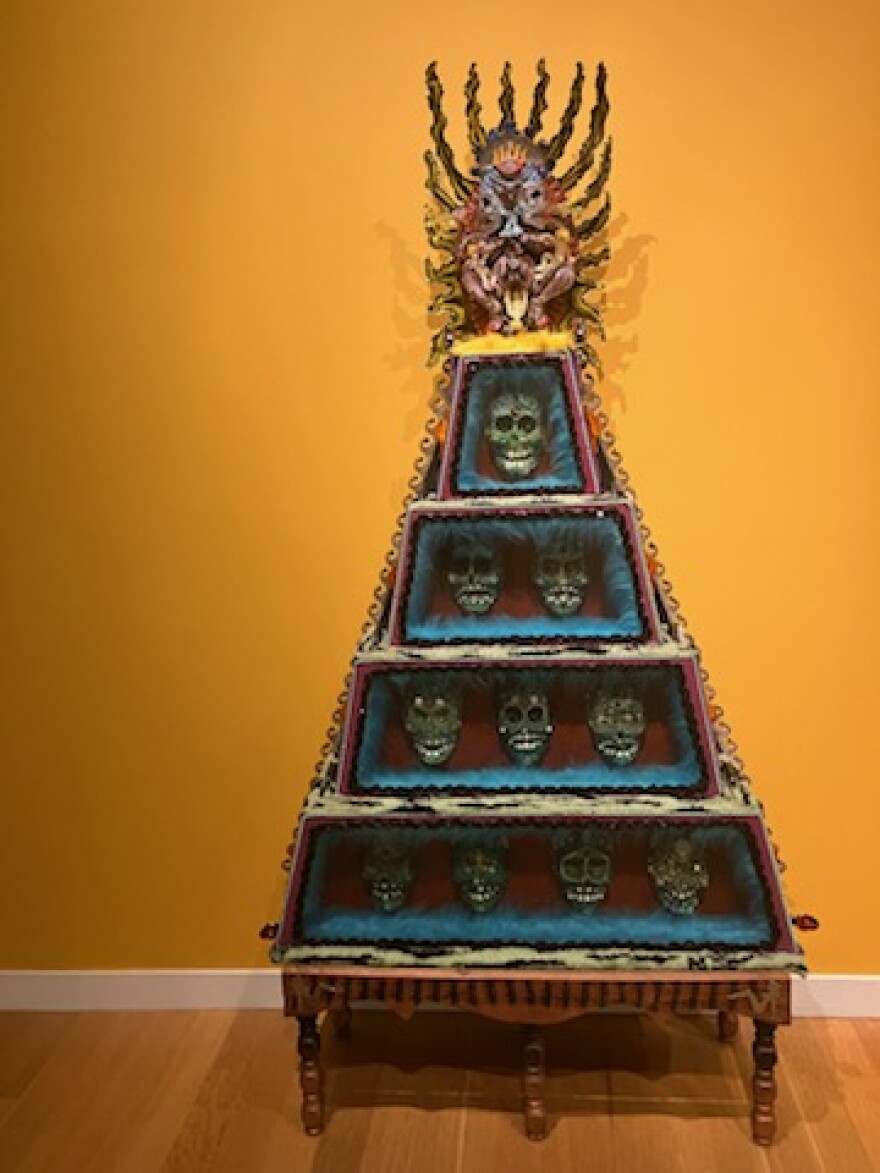
Glenn: And I saw a lot of human hearts in a lot of your pieces — and the skull figures, you know, with the teeth showing.
Einar: Well, the skull has an obvious direct connection to the Day of the Dead celebration, which is a reminder that we always have our death with us. And it's also a festive representation of what's inside all of us.
Glenn: Do you ever have people who say to you — as I heard a couple of people in the Mint saying — this one lady, she was looking and she just said, ‘I love the colors, but this is just crazy.’
Jamex: We’ve had people saying like, 'What are you guys on?' and that kind of commentary. We grew up with, you know, cartoons on the TV. And if you look at the cartoons we had when we were kids, they were mostly hitting each other all the time and getting eaten and slapped — and it was all about that.
Ah, we sort of let go of religion when we went to the United States because — so, let me tell you — a Catholic Church in Southern California was nothing like a Catholic Church in central Mexico. In terms of imagery and iconography, it’s a far cry.
But I think that's a valid thing to say. I mean, some people think that our work, because of the hearts and all these things, can seem violent. And we're not condoning or even expressing it, but we're also not shying away from the fact that humanity has a very violent background. We like to think that their work is a lot more joyous than that — that the color, the brightness, the funniness will draw people in and make them smile. But sure, there's going to be some people that frown. And that's OK, too. You can't be for everybody.
“Collidoscope: de la Torre Brothers Retro-Perspective” will be at The Mint Museum Uptown through Sept. 21. The Mint Museum is a frequent financial supporter of WFAE.

